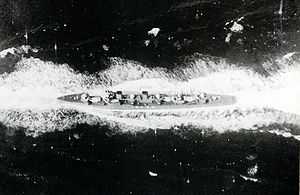Japanese destroyer Nadakaze
 Nadakaze on high speed trials, 1921 | |
| Career | |
|---|---|
| Name: | Nadakaze |
| Ordered: | 1918 fiscal year |
| Builder: | Maizuru Naval Arsenal |
| Laid down: | January 9, 1920 |
| Launched: | June 26, 1920 |
| Commissioned: | September 30, 1920 |
| Struck: | September 30, 1945 |
| Fate: | Sunk by British submarine HMS Stubborn, July 25, 1945 |
| General characteristics Nadakaze | |
| Class and type: | Minekaze-class destroyer |
| Displacement: | 1,345 long tons (1,367 t) normal, 1,650 long tons (1,680 t) full load |
| Length: | 97.5 m (320 ft) pp, 102.6 m (337 ft) overall |
| Beam: | 9 m (30 ft) |
| Draught: | 2.8 m (9.2 ft) |
| Propulsion: | 2-shaft Mitsubishi-Parsons geared turbines, 4 boilers 38,500 ihp (28,700 kW) |
| Speed: | 39 knots (72 km/h) |
| Range: | 3600 nm @ 14 knots (6,700 km at 26 km/h) |
| Complement: | 148 |
| Armament: | 4 × Type 3 120 mm 45 caliber naval gun 6 × 21 in (533 mm) torpedo tubes 2 × 7.7 mm machine guns |
| Notes: | Converted to Patrol Boat No.2 in April 1940 |
| General characteristics Patrol Boat No.2 | |
| Class and type: | Patrol Boat No.1 |
| Displacement: | 1,270 long tons (1,290 t) normal, 1,700 long tons (1,700 t) full load |
| Length: | 97.5 m (320 ft) pp, 102.6 m (337 ft) overall |
| Beam: | 9 m (30 ft) |
| Draught: | 2.9 m (9.5 ft) |
| Propulsion: | 2-shaft Mitsubishi-Parsons geared steam turbine, 2 boilers 19,250 ihp (14,350 kW) |
| Speed: | 20 knots (37 km/h) |
| Armament: | 2 × Type 3 120 mm 45 caliber naval gun 4 × triple Type 96 25 mm AT/AA Gun guns 18x depth charges |
| Service record | |
|---|---|
| Operations: |
Second Sino-Japanese War Pacific War |
Nadakaze (灘風 High Seas Wind)[1] was a Minekaze-class destroyer, built for the Imperial Japanese Navy immediately following World War I. Advanced for their time, the Minekaze class served as first-line destroyers through the 1930s, but were considered obsolescent by the start of the Pacific War. Nadakaze was re-rated as a patrol boat in 1940.
History
Construction of the large-sized Minekaze-class destroyers was authorized as part of the Imperial Japanese Navy's 8-4 Fleet Program from fiscal 1917–1920, as an accompaniment to the medium-sized Momi class, with which they shared many common design characteristics.[2] Equipped with powerful engines, these vessels were capable of high speeds and were intended as escorts for the projected Amagi-class battlecruisers, which were ultimately never built.[3] Nadakaze, built at the Maizuru Naval Arsenal, was the fourth ship of this class. It was laid down on January 8, 1920, launched on June 26, 1920 and commissioned on September 30, 1921 [4]
On completion, Nadakaze was assigned to Yokosuka Naval District as part of Destroyer Division 3 under the IJN 2nd Fleet. From 1937-1939, Nadakaze was assigned to patrols of the northern and central China coastlines in support of Japanese combat operations in the Second Sino-Japanese War. In December 1938, Destroyer Division 3 was disbanded, and Nadakaze was reassigned to the reserves.
As Patrol Boat No.2
In April 1940, after extensive modifications, Nadakaze was returned to active duty as a patrol boat, and renamed Patrol Boat No.2 ( 第二哨戒艇 Dai-ni Shokaitei). These modifications included a reduction in the number of boilers to two, which in turn cut her top speed to 20 knots. The number of Type 3 120 mm guns was likewise reduced from four to two, and all torpedo launchers were removed. In their place, four triple Type 96 25 mm AT/AA Guns were added, as well as 18 depth charges. The stern of the ship was modified to house two Toku Daihatsu-class landing craft, capable of landing 250 naval infantry troops.
After the start of the Pacific War, Patrol Boat No.2 was assigned to patrols and escort missions in the Philippines, Netherlands East Indies and Solomon Islands. In January 1943, Patrol Boat No.2 was reassigned to the Japanese home islands, escorting convoys between Moji, Takao, Saigon, Manila and Singapore. In December 1943, it became the designated support ship for Imperial Japanese Navy Land Forces based in Balikpapan, Borneo.
On July 25, 1945, it was torpedoed and sunk by the Royal Navy submarine HMS Stubborn near Lombok Strait, in the Lesser Sunda Islands, Netherlands East Indies at position 07°06′S 115°42′E / 7.100°S 115.700°ECoordinates: 07°06′S 115°42′E / 7.100°S 115.700°E.
Patrol Boat No.2 was removed from navy list on September 30, 1945.[5]
References
Books
- Brown, David (1990). Warship Losses of World War Two. Naval Institute Press. ISBN 1-55750-914-X.
- Howarth, Stephen (1983). The Fighting Ships of the Rising Sun: The Drama of the Imperial Japanese Navy, 1895–1945. Atheneum. ISBN 0-689-11402-8.
- Jentsura, Hansgeorg (1976). Warships of the Imperial Japanese Navy, 1869–1945. US Naval Institute Press. ISBN 0-87021-893-X.
- Nelson, Andrew N. (1967). Japanese–English Character Dictionary. Tuttle. ISBN 0-8048-0408-7.
- Watts, Anthony J (1967). Japanese Warships of World War II. Doubleday. ASIN B000KEV3J8.
- Whitley, M J (2000). Destroyers of World War Two: An International Encyclopedia. London: Arms and Armour Press. ISBN 1-85409-521-8.
External links
- Nishidah, Hiroshi (2002). "Minekaze class 1st class destroyers". Materials of the Imperial Japanese Navy.
- Jones, Daniel H. (2003). "IJN Minekaze, Kamikaze and Mutsuki class Destroyers". Ship Modeler's Mailing List (SMML).
Notes
- ↑ Nelson. Japanese-English Character Dictionary. pages 573, 960
- ↑ Howarth, The Fighting Ships of the Rising Sun.
- ↑ Globalsecurity.org, IJN Minekaze class destroyers.
- ↑ Nishidah, Hiroshi (2002). "Minekaze class 1st class destroyers". Materials of the Imperial Japanese Navy.
- ↑ Nishidah, Hiroshi (2002). "Minekaze class 1st class destroyers". Materials of the Imperial Japanese Navy.
| ||||||||||||||||||||||||||||||||